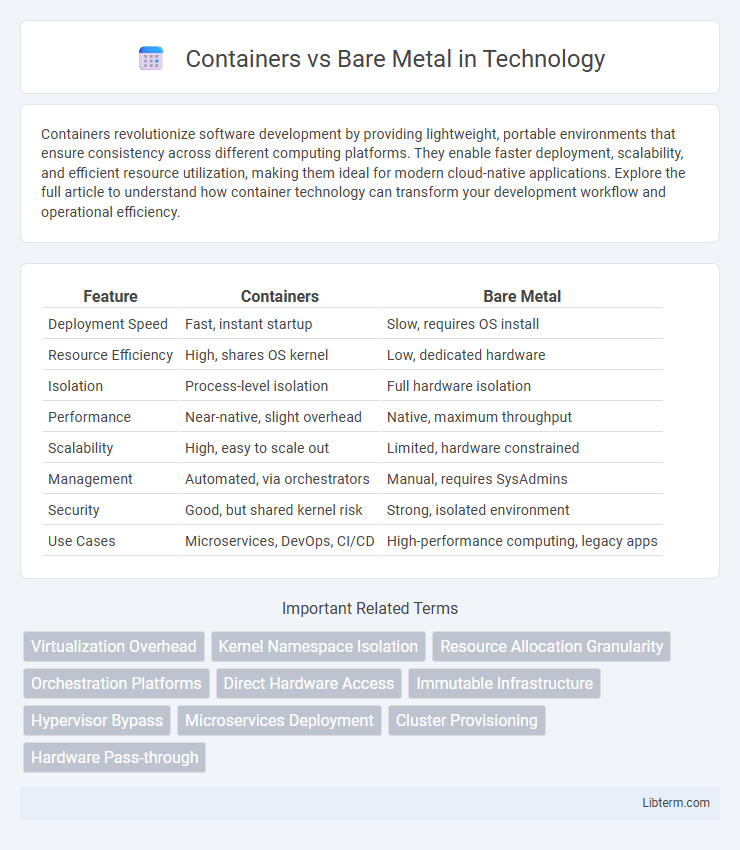Containers revolutionize software development by providing lightweight, portable environments that ensure consistency across different computing platforms. They enable faster deployment, scalability, and efficient resource utilization, making them ideal for modern cloud-native applications. Explore the full article to understand how container technology can transform your development workflow and operational efficiency.
Table of Comparison
| Feature | Containers | Bare Metal |
|---|---|---|
| Deployment Speed | Fast, instant startup | Slow, requires OS install |
| Resource Efficiency | High, shares OS kernel | Low, dedicated hardware |
| Isolation | Process-level isolation | Full hardware isolation |
| Performance | Near-native, slight overhead | Native, maximum throughput |
| Scalability | High, easy to scale out | Limited, hardware constrained |
| Management | Automated, via orchestrators | Manual, requires SysAdmins |
| Security | Good, but shared kernel risk | Strong, isolated environment |
| Use Cases | Microservices, DevOps, CI/CD | High-performance computing, legacy apps |
Understanding Containers and Bare Metal
Containers encapsulate applications and their dependencies in lightweight, portable units that run consistently across various environments, making them ideal for microservices and scalable cloud deployments. Bare metal servers provide direct hardware access without virtualization layers, offering maximum performance and control for workloads requiring intensive processing power or low latency. Understanding the trade-offs between containerization's agility and bare metal's raw hardware efficiency is crucial for optimizing infrastructure based on specific application needs.
Key Differences Between Containers and Bare Metal
Containers provide lightweight, portable environments by sharing the host OS kernel, enabling rapid deployment and resource efficiency. Bare metal servers offer dedicated hardware access without an intermediary layer, resulting in maximum performance and full control of system resources. Key differences include isolation levels, with containers running isolated processes atop a shared OS, while bare metal ensures exclusive hardware use for intensive workloads.
Performance Comparison: Containers vs Bare Metal
Bare metal servers deliver superior raw performance by providing dedicated access to hardware resources without virtualization overhead, crucial for latency-sensitive applications. Containers offer near-native performance by sharing the host OS kernel while enabling faster deployment and better resource utilization, but they introduce slight overhead compared to bare metal. Performance differences narrow significantly with optimized container runtimes and hardware support like CPU pinning and NUMA awareness, making containers viable for many high-performance workloads.
Security Considerations: Containers vs Bare Metal
Containers offer enhanced isolation through namespace and control group features, but share the host OS kernel, increasing attack surface compared to bare metal servers with dedicated hardware. Bare metal environments provide stronger security boundaries by eliminating kernel sharing, reducing risks from privilege escalation and kernel exploits common in containerized setups. Continuous monitoring and proper configuration of container runtime security policies are crucial to mitigating vulnerabilities inherent to container environments.
Scalability and Flexibility Analysis
Containers offer superior scalability by enabling rapid deployment and efficient resource utilization across diverse environments, while bare metal provides high-performance capacity tailored for predictable, resource-intensive workloads. Container orchestration tools like Kubernetes facilitate dynamic scaling and seamless application updates, enhancing operational flexibility compared to the fixed infrastructure of bare metal servers. Bare metal excels in scenarios requiring consistent, low-latency performance, but containers dominate in scalability and agile resource management for cloud-native applications.
Deployment Speed and Resource Efficiency
Containers enable rapid deployment by encapsulating applications and their dependencies, allowing instant scalability without the need for provisioning physical hardware. Bare metal servers offer direct access to hardware resources, resulting in optimized performance but slower deployment due to manual setup and configuration. Containers achieve higher resource efficiency through lightweight virtualization, maximizing server utilization and reducing overhead compared to bare metal environments.
Cost Implications and Total Cost of Ownership
Containers reduce infrastructure costs by enabling higher resource utilization and faster deployment compared to bare metal servers, which require significant upfront investment and ongoing maintenance expenses. Total cost of ownership (TCO) for containers is generally lower due to decreased hardware requirements, streamlined management, and scalability, while bare metal incurs higher operational costs from dedicated hardware, power consumption, and physical space. Containers also minimize downtime and improve agility, contributing to cost savings in development and operations over the lifecycle of applications.
Use Cases and Best Fit Scenarios
Containers are ideal for microservices, continuous integration/continuous delivery (CI/CD) pipelines, and scalable cloud-native applications due to their lightweight and portable nature. Bare metal servers excel in high-performance computing, large databases, and workloads requiring direct access to hardware resources for maximum speed and low latency. Enterprises benefit from containers in dynamic, multi-cloud environments, while bare metal is best suited for predictable, resource-intensive applications demanding full control over the infrastructure.
Limitations and Challenges
Containers face limitations such as restricted access to hardware resources and potential performance overhead due to abstraction layers, which can hinder applications demanding low latency or intensive computation. Security challenges also arise from container isolation weaknesses and shared kernel vulnerabilities, increasing the risk of exploits compared to bare metal environments. Bare metal offers superior control over hardware and consistent performance but lacks the rapid deployment and scalability advantages inherent to containerized solutions.
Future Trends in Infrastructure Deployment
Future trends in infrastructure deployment emphasize a hybrid approach combining containers and bare metal for optimized performance and scalability. Containers offer rapid application deployment and portability across multi-cloud environments while bare metal ensures maximum resource efficiency and low latency for critical workloads. Innovations in orchestration platforms and edge computing will further drive integration, enabling dynamic resource allocation tailored to diverse enterprise needs.
Containers Infographic

 libterm.com
libterm.com